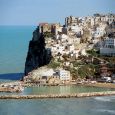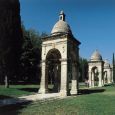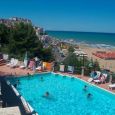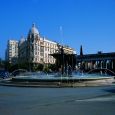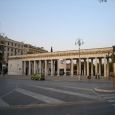Foggia
Advertisement
By Air
Foggia Airport ( IATA : FOG, ICAO : LIBF) is a civil airport located about 3 km from the center of the city of Foggia , accessible by bus and shuttle service.The basin of user of the airport Dauno is very broad, encompassing the whole province of Foggia, and parts of neighboring provinces of Barletta, Avellino, Benevento, Campobasso and Power.The airport, named after Gino Lisa, just in the past used to deficiencies in infrastructure and management difficulties, has a heliport for flights to the Gargano ( Tremiti, Peschici, San Giovanni Rotondo and Vieste ) and Daunian Apennine ( Celenza Valfortore ), made the company Alidaunia, and fly to Milan Malpensa, Turin and Palermo operated by the company Darwin in codeshare with Alitalia.In addition to regular bus lines of ATAF (lines 18, 19 and F7), the airport can be reached by bus "Airbus".
By Train
Foggia railway station, opened in 1864, forms part of the Adriatic Railway (Ancona–Lecce), and is the terminus of the Naples–Foggia railway.It is also a junction for several other, secondary lines, namely the Foggia–Manfredonia, Lucera–Foggia and Foggia–Potenza railways.
By Bus
The transport in the city are guaranteed by Foggia ATAF SpA (Foggia Automotive Transport Company), which serves over the city, villages and townships near the city, also belonging to the territory of other municipalities in the province, as Mezzanone Village (suburb of Manfredonia), but also Borgo Crowned, Segezia, Duanera Rocca, Cervaro Arpinova, Tavernola Eridania / Rignano Scalo, St. Nicholas of Arpi and Villanova (fraction of Rignano Garganico).All other links (with the municipalities of the province, regional, interregional and international) are run by three transport companies (SITA, Ferrovie del Gargano and ACAPT).
Advertisement
City Museum and Art Gallery
Home to three sections arranged on different levels of the museum.On the ground floor was home to the lapidary with the tomb of the Medusa, carried by the archaeological site of Arpi, and other archaeological finds which bear witness to the birth of Foggia, originally from the Neolithic, typed it, Roman and medieval.Upstairs was staged a reconstruction of a house on the model of the type of terrazzani; caskets are also in various jewelry and ornaments, such as bells and statues of saints belonging to citizens of Foggia, which, over time, have made a gift the museum.On the second floor are two galleries that host, the first, a large collection of archaeological finds from ancient Arpi and beyond, such as pottery, statues, tools, bronze objects and reconstructions of primitive habitations.The second gallery houses paintings of artists of great value especially as Foggia Francesco Saverio Altamura, Dominic Caldara, Vincenzo Dattoli, Neapolitan and southern school of various periods up to eight hundred.
Museum of the Archaeological Park of Passo di Corvo
is a museum near Arpinova , where there are relics of the Village Neolithic largest and among the oldest of Europe's (from the sixth to the fourth millennium BC).The archaeological site, discovered thanks to some aerial photographs taken during the second world war in the area of Foggia, was the cradle of agriculture in Italy, came from the peoples of the Middle East, which took advantage of the fertility of the board.And 'one of the few archaeological parks of Neolithic visited in Italy.
Palazzo Dogana
Triangular shaped Punta della Dogana separates the Grand Canal and the Giudecca Canal.As a center for contemporary art, the former customs house of the city presents a permanent exhibition of works from the François Pinault Collection, the institution who wanted and sponsered the transition of this masterpiece of architecture, so emblematic to the city, from its eminently commercial function to port of contemporary art and ideal venue to share it with the world.The customs houses, which were located at Castello close to the Arsenal, are divided into Customs of Land and Customs of Sea.The latter is then relocated to Punta della Dogana, at the tip of the island of Dorsoduro, named “Punta del Sale” because of the salt warehouses which were built there.From April 10th 2011 Punta della Dogana will show In Praise of Doubt, curated by Caroline Bourgeois, a presentation of historical pieces and new works including several site-specific projects that question the idea of uncertainty, our convictions about identity, and revisit the relationship between intimate space and the space of artwork.Among the twenty artists in the exhibition In Praise of Doubt, almost half of them have never been included in previous exhibitions of the François Pinault Collection.
Piazza Cavour
pentagonal in shape, is adorned by a central feature fountain called "Fountain of the Sele," but more commonly "Fontana di Piazza Cavour", placed in memory of the time when the city could receive, after long years of waiting, water of the river Sele.The backdrop to the nineteenth-century square is the elegant neo-classical portico which gives access to the villa.To the right rise the two domes that surround the palace Apulian Aqueduct while ago by the left corner of the simple and elegant façade of the building that now houses the University.Of the various sides that enclose the square, one of those who have not been touched by the massive reconstruction of buildings in the seventies is home to the Mandara palace, built in the nineteenth century.
Purgatory Square
one of the oldest squares in the old city, is also mentioned in maps of the Middle Ages. According to studies established stands in the place where Frederick II had built his magnificent palace.The building is most important is the baroque Church of St. Maria della Misericordia, also known as the souls in Purgatory, or the Dead, currently under renovation, hidden inside one of the finest examples of Apulian Baroque.
Square Lake
named for the ancient presence of a small pond where, according to legend, two shepherds saw a wooden board on which emerge from the water and floated three flames.After having cleaned the mud, the two pastors recognized the face of a Virgin and Child, and brought to safety in the old tavern of the owl.Currently there is a fountain to commemorate the lake.
Patronal Feast
falls on March 22 and is dedicated to the Madonna of the Seven Veils, the patron saint of Foggia.For the main city streets has organized a procession.
January - March
August - October
Information not available
Advertisement

